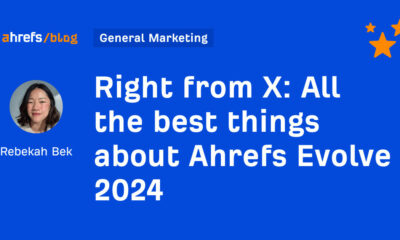SEO
Why Brand Awareness Is The 5th Pillar Of SEO

Search engine optimization (SEO) is a marketing practice for increasing a website’s organic traffic through search engines.
It consists of techniques in four key areas: keyword and content, technical SEO, on-site SEO, and off-site SEO.
These four areas are typically considered the four pillars of SEO. They work together to help a website rank well on search engines.
However, even as extensive as these four pillars are, an SEO strategy isn’t complete if it ignores brand awareness.
In this article, you’ll learn why SEO marketers should consider brand awareness as the fifth pillar of SEO.
The First Four Pillars Of SEO
Before we look into the fifth pillar, let’s review the first four pillars of SEO:
Keyword And Content
Content rules – and keywords are the foundation of search.
A good piece of keyword-optimized content is the building block of an SEO strategy.
Technical SEO
Great content is insufficient if the website hosting doesn’t have a sound technical foundation.
Technical SEO covers areas like indexability and performance of the website.
It ensures a website loads its pages fast, and search engines can easily crawl the content.
Notably, Google has developed a set of metrics called Core Web Vitals to measure a web page’s technical performance and usability.
On-Site SEO
This pillar helps search engines understand the page’s content by creating a better website structure and its pages.
Site navigation hierarchy, schema markup, page titles, meta descriptions, heading tags, and image alt text are tools to create an easy-to-understand website and page structure for search engine crawlers and visitors.
Off-Site SEO
Having great content and a great website is just the beginning.
A website can’t rank well on search engines if it lacks authority and doesn’t garner trust in its subject domain.
From the onset, Google uses the amount and quality of backlinks as an indicator to evaluate a website’s authority.
Nevertheless, even as far-reaching as these four areas appear in creating a search-optimized website, they can only help drive part of your website’s search traffic, i.e., the type of traffic coming from non-branded searches.
Non-Branded Vs. Branded Searches
What are non-branded searches, and how are they different from branded searches?
Branded Queries
They contain branded names in the search terms.
If you’re Apple Inc., the search term “apple” is a branded term.
Yes, Google knows you’re looking for the company founded by Steve Jobs and Steve Wozniak rather than the fruit. Moreover, “iPhone,” ‘iPad,” and “MacBook” are also branded terms.
Branded searches are conducted by people looking for information, especially about your brand or products.
Non-Branded Queries
On the other hand, non-branded queries don’t contain any branded name in the search terms. Again, for Apple Inc., “laptop,” “smartphone,” and “tablet” are non-branded terms related to its products.
Non-branded searches are from people who may not know about your brand or products but are looking for information about the type of products or solutions you offer.
With this in mind, for a brand as strong as Apple, you may think its search traffic is largely from branded searches. And, for the most part, you’d be correct.
According to Semrush, more than half of search traffic to Apple’s website comes from branded searches.
Why Is Branded Search Important?
Branded search traffic not only reflects the level of interest of a specific brand, but also has higher commercial intent and a higher conversion rate.
Generally speaking, non-branded search traffic feeds the upper part of the marketing funnel, and branded search traffic feeds the lower part of the funnel.
A brand needs to grow both types of traffic to maintain a healthy and growing business.
That said, most businesses don’t have the level of brand recognition like Apple’s.
What can marketers do to drive branded search traffic to a website?
Different Traffic Drivers For Non-Branded And Branded Searches
As illustrated by the formula below, search traffic is driven by two factors: keyword search volume and clickthrough rate (CTR) on the search engine results page (SERP).
A website with high aggregated keyword search volume and clickthrough rate will have high search traffic.
Search traffic = Keyword search volume * Clickthrough rate
Wait a minute! Where does keyword ranking fit into the equation?
Keyword ranking is, in fact, a critical factor in determining the clickthrough rate.
The higher your keywords rank, the higher the clickthrough rate you get.
According to Advanced Web Ranking, position #1 on Google can have a 38% CTR. CTR drops to about 5% on position #5 and stays around 1% or below after position #10.
Bearing that in mind, how do the four pillars of SEO contribute to a website’s search traffic?
They help a website increase its search traffic in two ways:
- Maximizing the aggregated keyword search volume through keyword research and targeting.
- Improving keyword ranking to achieve a higher SERP clickthrough rate through valuable and keyword-optimized content, technical SEO, and on-site and off-site optimization.
Nevertheless, the problem is that these SEO techniques work on mostly non-branded searches only.
They have limited effect on branded search, because branded search and non-branded search have different traffic drivers.
Non-Branded Traffic Driver
For non-branded search, a website can harvest a virtually unlimited amount of keywords and aggregated search volume.
The main lever of non-branded search traffic is improving your target keywords’ ranking to gain a higher clickthrough rate and capture a larger share of the search clicks.
Branded Traffic Driver
For branded search, assuming your website is already ranked No. 1 for your brand name (if not, you need to fix this problem first), ranking is generally not an issue.
As the brand owner, you always have an advantage on Google for your branded keywords.
The main lever of branded search traffic is simply increasing your branded keywords’ search volume.
However, the first four pillars of SEO have little effect on getting more people to search for your brand or your products.
As a result, they are ineffective on branded search.
How To Grow Brand Awareness & Branded Search
In short, branded search traffic results from a brand’s awareness and interest.
People wouldn’t search for your brand if they didn’t know or have any interest in your brand or your offerings.
To grow brand awareness and interest, you need to increase a brand’s visibility to its potential customers, develop authority, and garner trust for the brand.
Content marketing and the growth of non-branded search traffic could help increase brand awareness.
However, solely relying on people coming to your website to learn about your brand and offerings won’t take you very far.
To grow brand awareness at scale, marketers need to bring their brand to their potential customers. You can’t just wait for them to come to you.
Luckily, there are plenty of tools in the digital marketing arsenal to help marketers build brand awareness, including advertising, influencer marketing, customer marketing, and digital PR.
Advertising
At AdRoll, we classify advertising into two categories: retargeting and brand awareness campaigns.
As the names suggest, retargeting campaigns target people who have engaged with you (e.g., visited your website), and brand awareness campaigns target potential customers who have not yet interacted with you.
Marketers can choose from several targeting methods to bring your brand to potential customers.
Contextual Targeting
Contextual targeting is one of the oldest advertising targeting methods.
Think of a hotel chain placing its ads in a travel magazine. A brand can place ads on websites or mobile apps with content relevant to its products or services.
A big difference between contextual targeting and other targeting methods is that contextual targeting doesn’t rely on personal or behavioral data about the target audience.
It’s a more privacy-friendly way for marketers to find and connect with their potential customers.
With regulators and technology companies looking at ways to improve consumer privacy protection, the importance of contextual targeting to advertisers is likely to increase.
Demographic And Interest Targeting
Demographic and interest targeting leverages your knowledge of existing customers to find new customers.
Suppose your customers fit into any specific demographic segment or are interested in certain activities or subjects. In that case, you can bring your brand to potential customers by running ads targeting people with similar demographic characteristics or interests.
Lookalike Targeting
Lookalike targeting is similar to demographic and interest targeting.
But, instead of manually defining the target audience segment based on a list of demographic or interest attributes – advertising platforms use machine learning technologies to find target audiences who look or behave similarly to the seed audience provided by marketers.
The seed audience is typically a subset of existing customers.
Influencer Marketing
Influencer marketing covers a broad range of tactics for leveraging someone who influences your target customers to promote your brand and products.
Even before the digital age, it was common for big brands to hire famous athletes or celebrities to endorse their products. Think Michael Jordan and Nike in the ‘80s.
Today, “influencers ” are social media personalities who have built a following with a particular audience.
The vast number of influencers on social media also means influencer marketing is no longer a privilege available only to those brands with deep pockets.
Marketers can recruit influencers at very low or no cost by reaching out to those who have shown interest or already invested in the niche you serve, including your customers (more on that in the next section).
While many influencer marketing activities are in the B2C sector, it also works for B2B.
Customer Marketing
When you shop at an ecommerce marketplace, such as Amazon, you might look at the product reviews before making a purchase decision.
The number and rating of a product’s reviews are also ranking factors for product searches on Amazon.com.
The more people review a product and the higher the review rating, the more visibility and traffic a product gets.
The same logic applies even if Amazon may not be the channel for your business.
For B2B SaaS providers, customer reviews on G2, Trustpilot, etc., play the same role.
For direct-to-consumer (D2C) brands, customer reviews and sharing on social media bring your brand and products to new customers and help establish trust for your brand.
Take Halfbikes.com as an example.
This D2C company from Bulgaria has a team of brand ambassadors – their customers – all around the world to promote its brand and product simply by sharing their experiences on social media.
Some of their customers even created YouTube channels dedicated to Halfbikes.
Digital PR
Among all the strategies driving brand awareness, digital PR is the one most directly related to SEO. In fact, it’s often considered “link building 2.0.”
The main difference between link building and digital PR is that link building focuses on acquiring links from other websites.
In contrast, digital PR focuses on bringing your brand to your target audiences through stories published in relevant and high-quality publications.
The types of stories vary depending on the industries and subjects.
Take Facebook’s name change to Meta. In that context, the topic of how consumers perceive the metaverse, for instance, could make an interesting story for B2C marketers.
Because well-known publications usually have very strict link policies, digital PR prioritizes brand visibility and reach, whereas link acquisition is a secondary goal.
Brand Awareness Is The Fifth Pillar Of SEO
One of the goals of a comprehensive marketing strategy should be to grow a brand’s awareness – just as a comprehensive SEO strategy should aim at growing both non-branded and branded searches.
While non-branded search traffic is driven by keyword ranking, branded search traffic is mostly driven by the search volume of the branded keywords.
The more people are aware of and interested in a brand, the higher branded search traffic a brand gets.
Given the different growth drivers of branded and non-branded searches, SEO professionals need to include brand awareness as a pillar of SEO.
More resources:
Featured Image: batjaket/Shutterstock
SEO
How to Revive an Old Blog Article for SEO

Quick question: What do you typically do with your old blog posts? Most likely, the answer is: Not much.
If that’s the case, you’re not alone. Many of us in SEO and content marketing tend to focus on continuously creating new content, rather than leveraging our existing blog posts.
However, here’s the reality—Google is becoming increasingly sophisticated in evaluating content quality, and we need to adapt accordingly. Just as it’s easier to encourage existing customers to make repeat purchases, updating old content on your website is a more efficient and sustainable strategy in the long run.
Ways to Optimize Older Content
Some of your old content might not be optimized for SEO very well, rank for irrelevant keywords, or drive no traffic at all. If the quality is still decent, however, you should be able to optimize it properly with little effort.
Refresh Content
If your blog post contains a specific year or mentions current events, it may become outdated over time. If the rest of the content is still relevant (like if it’s targeting an evergreen topic), simply updating the date might be all you need to do.
Rewrite Old Blog Posts
When the content quality is low (you might have greatly improved your writing skills since you’ve written the post) but the potential is still there, there’s not much you can do apart from rewriting an old blog post completely.
This is not a waste—you’re saving time on brainstorming since the basic structure is already in place. Now, focus on improving the quality.
Delete Old Blog Posts
You might find a blog post that just seems unusable. Should you delete your old content? It depends. If it’s completely outdated, of low quality, and irrelevant to any valuable keywords for your website, it’s better to remove it.
Once you decide to delete the post, don’t forget to set up a 301 redirect to a related post or page, or to your homepage.
Promote Old Blog Posts
Sometimes all your content needs is a bit of promotion to start ranking and getting traffic again. Share it on your social media, link to it from a new post – do something to get it discoverable again to your audience. This can give it the boost it needs to attract organic links too.
Which Blog Posts Should You Update?
Deciding when to update or rewrite blog posts is a decision that relies on one important thing: a content audit.
Use your Google Analytics to find out which blog posts used to drive tons of traffic, but no longer have the same reach. You can also use Google Search Console to find out which of your blog posts have lost visibility in comparison to previous months. I have a guide on website analysis using Google Analytics and Google Search Console you can follow.
If you use keyword tracking tools like SE Ranking, you can also use the data it provides to come up with a list of blog posts that have dropped in the rankings.
Make data-driven decisions to identify which blog posts would benefit from these updates – i.e., which ones still have the chance to recover their keyword rankings and organic traffic.
With Google’s helpful content update, which emphasizes better user experiences, it’s crucial to ensure your content remains relevant, valuable, and up-to-date.
How To Update Old Blog Posts for SEO
Updating articles can be an involved process. Here are some tips and tactics to help you get it right.
Author’s Note: I have a Comprehensive On-Page SEO Checklist you might also be interested in following while you’re doing your content audit.
Conduct New Keyword Research
Updating your post without any guide won’t get you far. Always do your keyword research to understand how users are searching for your given topic.
Proper research can also show you relevant questions and sections that can be added to the blog post you’re updating or rewriting. Make sure to take a look at the People Also Ask (PAA) section that shows up when you search for your target keyword. Check out other websites like Answer The Public, Reddit, and Quora to see what users are looking for too.
Look for New Ranking Opportunities
When trying to revive an old blog post for SEO, keep an eye out for new SEO opportunities (e.g., AI Overview, featured snippets, and related search terms) that didn’t exist when you first wrote your blog post. Some of these features can be targeted by the new content you will add to your post, if you write with the aim to be eligible for it.
Rewrite Headlines and Meta Tags
If you want to attract new readers, consider updating your headlines and meta tags.
Your headlines and meta tags should fulfill these three things:
- Reflect the rewritten and new content you’ve added to the blog post.
- Be optimized for the new keywords it’s targeting (if any).
- Appeal to your target audience – who may have changed tastes from when the blog post was originally made.
Remember that your meta tags in particular act like a brief advertisement for your blog post, since this is what the user first sees when your blog post is shown in the search results page.
Take a look at your blog post’s click-through rate on Google Search Console – if it falls below 2%, it’s definitely time for new meta tags.
Replace Outdated Information and Statistics
Updating blog content with current studies and statistics enhances the relevance and credibility of your post. By providing up-to-date information, you help your audience make better, well-informed decisions, while also showing that your content is trustworthy.
Tighten or Expand Ideas
Your old content might be too short to provide real value to users – or you might have rambled on and on in your post. It’s important to evaluate whether you need to make your content more concise, or if you need to elaborate more.
Keep the following tips in mind as you refine your blog post’s ideas:
- Evaluate Helpfulness: Measure how well your content addresses your readers’ pain points. Aim to follow the E-E-A-T model (Experience, Expertise, Authoritativeness, Trustworthiness).
- Identify Missing Context: Consider whether your content needs more detail or clarification. View it from your audience’s perspective and ask if the information is complete, or if more information is needed.
- Interview Experts: Speak with industry experts or thought leaders to get fresh insights. This will help support your writing, and provide unique points that enhance the value of your content.
- Use Better Examples: Examples help simplify complex concepts. Add new examples or improve existing ones to strengthen your points.
- Add New Sections if Needed: If your content lacks depth or misses a key point, add new sections to cover these areas more thoroughly.
- Remove Fluff: Every sentence should contribute to the overall narrative. Eliminate unnecessary content to make your post more concise.
- Revise Listicles: Update listicle items based on SEO recommendations and content quality. Add or remove headings to stay competitive with higher-ranking posts.
Improve Visuals and Other Media
No doubt that there are tons of old graphics and photos in your blog posts that can be improved with the tools we have today. Make sure all of the visuals used in your content are appealing and high quality.
Update Internal and External Links
Are your internal and external links up to date? They need to be for your SEO and user experience. Outdated links can lead to broken pages or irrelevant content, frustrating readers and hurting your site’s performance.
You need to check for any broken links on your old blog posts, and update them ASAP. Updating your old blog posts can also lead to new opportunities to link internally to other blog posts and pages, which may not have been available when the post was originally published.
Optimize for Conversions
When updating content, the ultimate goal is often to increase conversions. However, your conversion goals may have changed over the years.
So here’s what you need to check in your updated blog post. First, does the call-to-action (CTA) still link to the products or services you want to promote? If not, update it to direct readers to the current solution or offer.
Second, consider where you can use different conversion strategies. Don’t just add a CTA at the end of the post.
Last, make sure that the blog post leverages product-led content. It’s going to help you mention your products and services in a way that feels natural, without being too pushy. Being subtle can be a high ROI tactic for updated posts.
Key Takeaway
Reviving old blog articles for SEO is a powerful strategy that can breathe new life into your content and boost your website’s visibility. Instead of solely focusing on creating new posts, taking the time to refresh existing content can yield impressive results, both in terms of traffic and conversions.
By implementing these strategies, you can transform old blog posts into valuable resources that attract new readers and retain existing ones. So, roll up your sleeves, dive into your archives, and start updating your content today—your audience and search rankings will thank you!
SEO
How Compression Can Be Used To Detect Low Quality Pages

The concept of Compressibility as a quality signal is not widely known, but SEOs should be aware of it. Search engines can use web page compressibility to identify duplicate pages, doorway pages with similar content, and pages with repetitive keywords, making it useful knowledge for SEO.
Although the following research paper demonstrates a successful use of on-page features for detecting spam, the deliberate lack of transparency by search engines makes it difficult to say with certainty if search engines are applying this or similar techniques.
What Is Compressibility?
In computing, compressibility refers to how much a file (data) can be reduced in size while retaining essential information, typically to maximize storage space or to allow more data to be transmitted over the Internet.
TL/DR Of Compression
Compression replaces repeated words and phrases with shorter references, reducing the file size by significant margins. Search engines typically compress indexed web pages to maximize storage space, reduce bandwidth, and improve retrieval speed, among other reasons.
This is a simplified explanation of how compression works:
- Identify Patterns:
A compression algorithm scans the text to find repeated words, patterns and phrases - Shorter Codes Take Up Less Space:
The codes and symbols use less storage space then the original words and phrases, which results in a smaller file size. - Shorter References Use Less Bits:
The “code” that essentially symbolizes the replaced words and phrases uses less data than the originals.
A bonus effect of using compression is that it can also be used to identify duplicate pages, doorway pages with similar content, and pages with repetitive keywords.
Research Paper About Detecting Spam
This research paper is significant because it was authored by distinguished computer scientists known for breakthroughs in AI, distributed computing, information retrieval, and other fields.
Marc Najork
One of the co-authors of the research paper is Marc Najork, a prominent research scientist who currently holds the title of Distinguished Research Scientist at Google DeepMind. He’s a co-author of the papers for TW-BERT, has contributed research for increasing the accuracy of using implicit user feedback like clicks, and worked on creating improved AI-based information retrieval (DSI++: Updating Transformer Memory with New Documents), among many other major breakthroughs in information retrieval.
Dennis Fetterly
Another of the co-authors is Dennis Fetterly, currently a software engineer at Google. He is listed as a co-inventor in a patent for a ranking algorithm that uses links, and is known for his research in distributed computing and information retrieval.
Those are just two of the distinguished researchers listed as co-authors of the 2006 Microsoft research paper about identifying spam through on-page content features. Among the several on-page content features the research paper analyzes is compressibility, which they discovered can be used as a classifier for indicating that a web page is spammy.
Detecting Spam Web Pages Through Content Analysis
Although the research paper was authored in 2006, its findings remain relevant to today.
Then, as now, people attempted to rank hundreds or thousands of location-based web pages that were essentially duplicate content aside from city, region, or state names. Then, as now, SEOs often created web pages for search engines by excessively repeating keywords within titles, meta descriptions, headings, internal anchor text, and within the content to improve rankings.
Section 4.6 of the research paper explains:
“Some search engines give higher weight to pages containing the query keywords several times. For example, for a given query term, a page that contains it ten times may be higher ranked than a page that contains it only once. To take advantage of such engines, some spam pages replicate their content several times in an attempt to rank higher.”
The research paper explains that search engines compress web pages and use the compressed version to reference the original web page. They note that excessive amounts of redundant words results in a higher level of compressibility. So they set about testing if there’s a correlation between a high level of compressibility and spam.
They write:
“Our approach in this section to locating redundant content within a page is to compress the page; to save space and disk time, search engines often compress web pages after indexing them, but before adding them to a page cache.
…We measure the redundancy of web pages by the compression ratio, the size of the uncompressed page divided by the size of the compressed page. We used GZIP …to compress pages, a fast and effective compression algorithm.”
High Compressibility Correlates To Spam
The results of the research showed that web pages with at least a compression ratio of 4.0 tended to be low quality web pages, spam. However, the highest rates of compressibility became less consistent because there were fewer data points, making it harder to interpret.
Figure 9: Prevalence of spam relative to compressibility of page.
The researchers concluded:
“70% of all sampled pages with a compression ratio of at least 4.0 were judged to be spam.”
But they also discovered that using the compression ratio by itself still resulted in false positives, where non-spam pages were incorrectly identified as spam:
“The compression ratio heuristic described in Section 4.6 fared best, correctly identifying 660 (27.9%) of the spam pages in our collection, while misidentifying 2, 068 (12.0%) of all judged pages.
Using all of the aforementioned features, the classification accuracy after the ten-fold cross validation process is encouraging:
95.4% of our judged pages were classified correctly, while 4.6% were classified incorrectly.
More specifically, for the spam class 1, 940 out of the 2, 364 pages, were classified correctly. For the non-spam class, 14, 440 out of the 14,804 pages were classified correctly. Consequently, 788 pages were classified incorrectly.”
The next section describes an interesting discovery about how to increase the accuracy of using on-page signals for identifying spam.
Insight Into Quality Rankings
The research paper examined multiple on-page signals, including compressibility. They discovered that each individual signal (classifier) was able to find some spam but that relying on any one signal on its own resulted in flagging non-spam pages for spam, which are commonly referred to as false positive.
The researchers made an important discovery that everyone interested in SEO should know, which is that using multiple classifiers increased the accuracy of detecting spam and decreased the likelihood of false positives. Just as important, the compressibility signal only identifies one kind of spam but not the full range of spam.
The takeaway is that compressibility is a good way to identify one kind of spam but there are other kinds of spam that aren’t caught with this one signal. Other kinds of spam were not caught with the compressibility signal.
This is the part that every SEO and publisher should be aware of:
“In the previous section, we presented a number of heuristics for assaying spam web pages. That is, we measured several characteristics of web pages, and found ranges of those characteristics which correlated with a page being spam. Nevertheless, when used individually, no technique uncovers most of the spam in our data set without flagging many non-spam pages as spam.
For example, considering the compression ratio heuristic described in Section 4.6, one of our most promising methods, the average probability of spam for ratios of 4.2 and higher is 72%. But only about 1.5% of all pages fall in this range. This number is far below the 13.8% of spam pages that we identified in our data set.”
So, even though compressibility was one of the better signals for identifying spam, it still was unable to uncover the full range of spam within the dataset the researchers used to test the signals.
Combining Multiple Signals
The above results indicated that individual signals of low quality are less accurate. So they tested using multiple signals. What they discovered was that combining multiple on-page signals for detecting spam resulted in a better accuracy rate with less pages misclassified as spam.
The researchers explained that they tested the use of multiple signals:
“One way of combining our heuristic methods is to view the spam detection problem as a classification problem. In this case, we want to create a classification model (or classifier) which, given a web page, will use the page’s features jointly in order to (correctly, we hope) classify it in one of two classes: spam and non-spam.”
These are their conclusions about using multiple signals:
“We have studied various aspects of content-based spam on the web using a real-world data set from the MSNSearch crawler. We have presented a number of heuristic methods for detecting content based spam. Some of our spam detection methods are more effective than others, however when used in isolation our methods may not identify all of the spam pages. For this reason, we combined our spam-detection methods to create a highly accurate C4.5 classifier. Our classifier can correctly identify 86.2% of all spam pages, while flagging very few legitimate pages as spam.”
Key Insight:
Misidentifying “very few legitimate pages as spam” was a significant breakthrough. The important insight that everyone involved with SEO should take away from this is that one signal by itself can result in false positives. Using multiple signals increases the accuracy.
What this means is that SEO tests of isolated ranking or quality signals will not yield reliable results that can be trusted for making strategy or business decisions.
Takeaways
We don’t know for certain if compressibility is used at the search engines but it’s an easy to use signal that combined with others could be used to catch simple kinds of spam like thousands of city name doorway pages with similar content. Yet even if the search engines don’t use this signal, it does show how easy it is to catch that kind of search engine manipulation and that it’s something search engines are well able to handle today.
Here are the key points of this article to keep in mind:
- Doorway pages with duplicate content is easy to catch because they compress at a higher ratio than normal web pages.
- Groups of web pages with a compression ratio above 4.0 were predominantly spam.
- Negative quality signals used by themselves to catch spam can lead to false positives.
- In this particular test, they discovered that on-page negative quality signals only catch specific types of spam.
- When used alone, the compressibility signal only catches redundancy-type spam, fails to detect other forms of spam, and leads to false positives.
- Combing quality signals improves spam detection accuracy and reduces false positives.
- Search engines today have a higher accuracy of spam detection with the use of AI like Spam Brain.
Read the research paper, which is linked from the Google Scholar page of Marc Najork:
Detecting spam web pages through content analysis
Featured Image by Shutterstock/pathdoc
SEO
New Google Trends SEO Documentation

Google Search Central published new documentation on Google Trends, explaining how to use it for search marketing. This guide serves as an easy to understand introduction for newcomers and a helpful refresher for experienced search marketers and publishers.
The new guide has six sections:
- About Google Trends
- Tutorial on monitoring trends
- How to do keyword research with the tool
- How to prioritize content with Trends data
- How to use Google Trends for competitor research
- How to use Google Trends for analyzing brand awareness and sentiment
The section about monitoring trends advises there are two kinds of rising trends, general and specific trends, which can be useful for developing content to publish on a site.
Using the Explore tool, you can leave the search box empty and view the current rising trends worldwide or use a drop down menu to focus on trends in a specific country. Users can further filter rising trends by time periods, categories and the type of search. The results show rising trends by topic and by keywords.
To search for specific trends users just need to enter the specific queries and then filter them by country, time, categories and type of search.
The section called Content Calendar describes how to use Google Trends to understand which content topics to prioritize.
Google explains:
“Google Trends can be helpful not only to get ideas on what to write, but also to prioritize when to publish it. To help you better prioritize which topics to focus on, try to find seasonal trends in the data. With that information, you can plan ahead to have high quality content available on your site a little before people are searching for it, so that when they do, your content is ready for them.”
Read the new Google Trends documentation:
Get started with Google Trends
Featured Image by Shutterstock/Luis Molinero














You must be logged in to post a comment Login